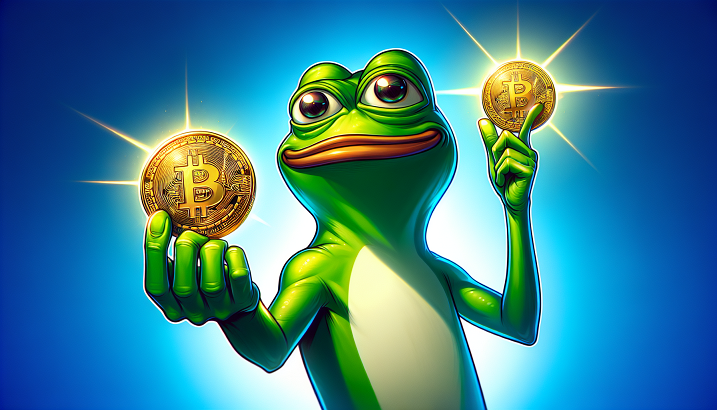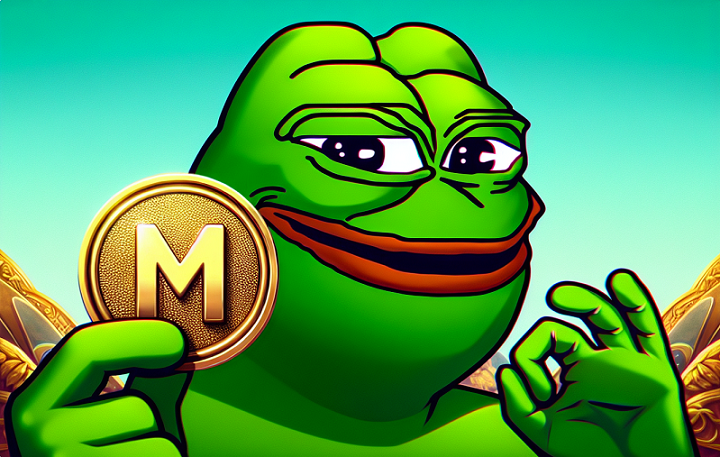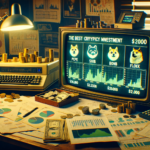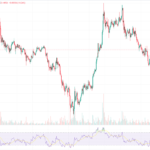In the realm of digital art and cryptocurrency, a peculiar and fascinating trend has been gaining momentum – the Pepe Bullish phenomenon. What exactly lies behind the enigmatic rise of this cultural icon turned financial symbol, and how has it managed to capture the imagination of both art enthusiasts and crypto investors alike? Brace yourself as we delve deep into the heart of this unconventional fusion in our comprehensive analysis.
As we navigate through the colorful landscape where memes meet markets, one can’t help but be intrigued by the unexpected synergy that has given birth to the Pepe Bullish craze. From its humble origins as a beloved internet meme to its recent metamorphosis into a symbol of financial optimism, the journey of Pepe the Frog embodies a fascinating narrative of evolution and adaptation. Join us on a thought-provoking exploration as we uncover the layers of significance behind the Pepe Bullish phenomenon and unravel the intriguing connections between art, culture, and the ever-fluctuating world of cryptocurrency.
The Origins of Pepe: From Meme to Market Symbol
Pepe the Frog, the green anthropomorphic amphibian with a mischievous grin, first emerged as a meme in the early 2000s. Created by artist Matt Furie, Pepe quickly gained popularity on internet forums and image boards due to his relatable and humorous expressions. What started as a simple character soon became an internet sensation, with users creating countless variations and sharing them across social media platforms.
However, it wasn’t until years later that Pepe’s journey took an unexpected turn. In 2016, during the U.S. presidential election campaign, Pepe was co-opted by certain political groups and associated with controversial ideologies. This led to widespread media coverage and public scrutiny of the character.
Despite this negative attention, Pepe’s cultural significance continued to evolve. The frog became a symbol of resistance against mainstream narratives and a representation of internet subculture. It was during this time that Pepe started gaining traction in the world of finance.
The Evolution of the Pepe Bullish Trend
The concept of “bullish” refers to an optimistic outlook on financial markets or specific assets. In recent years, investors have adopted various symbols and icons to represent their bullish sentiments towards certain cryptocurrencies or stocks. And it was in this context that Pepe found its place as a bullish symbol.
As cryptocurrency gained popularity and entered mainstream consciousness, investors sought new ways to express their enthusiasm for digital assets. The unique combination of Pepe’s cultural relevance and his association with memes made him an ideal candidate for representing this bullish sentiment.
Crypto enthusiasts began using images of Pepe alongside hashtags like #Pepecoin or #PepeBullish to convey their belief in positive market trends. This fusion of internet culture and finance created a new phenomenon that captured the attention of both seasoned investors and newcomers to the crypto space.

Unpacking the Cultural Significance of Pepe the Frog
Pepe’s journey from meme to market symbol highlights the interconnectedness of art, culture, and finance. The cultural significance of Pepe lies in its ability to transcend traditional boundaries and resonate with a diverse range of individuals.
Pepe represents a form of digital art that emerged from internet subculture. It embodies the power of memes to shape popular discourse and influence public opinion. The frog’s transformation into a financial symbol reflects the ever-evolving nature of cultural icons and their ability to adapt to new contexts.
Furthermore, Pepe’s popularity is indicative of a broader trend in which internet culture has permeated various aspects of society, including finance. As social media platforms continue to play an influential role in shaping public sentiment, it is no surprise that memes like Pepe have found their way into investment discussions.
The Intersection of Art and Finance in the Pepe Bullish Phenomenon
The fusion of art and finance is not a new concept. Throughout history, artists have often been at the forefront of challenging societal norms and pushing boundaries. In the case of Pepe Bullish, this intersection manifests itself through the creative use of an internet meme as a financial symbol.
The Pepe Bullish phenomenon showcases how art can transcend its traditional confines and find expression in unexpected places. By adopting Pepe as a bullish icon, investors are not only expressing their optimism but also engaging with contemporary artistic movements that blur the lines between digital culture and traditional forms.
This convergence between art and finance highlights the transformative power that memes can have on our perception of value. In an increasingly digitized world, where intangible assets hold significant worth, the Pepe Bullish phenomenon serves as a reminder of the fluid nature of art and its ability to transcend traditional boundaries.
Analyzing the Role of Social Media in Propelling Pepe to Prominence
Social media platforms have played a pivotal role in the rise of Pepe as a financial symbol. The viral nature of memes, combined with the reach and influence of platforms like Twitter and Reddit, has allowed Pepe to gain widespread recognition.
These platforms serve as catalysts for spreading ideas and shaping public sentiment. The use of hashtags and trending topics enables investors to rally around specific symbols or concepts, amplifying their impact on market discussions.
Pepe’s journey from meme to market symbol is a testament to the power of social media in driving cultural phenomena. It demonstrates how online communities can shape narratives and influence investment decisions, blurring the lines between virtual and physical realities.

Pepe as a Reflection of Internet Subculture
Pepe’s enduring popularity can be attributed to its status as an icon within internet subculture. The frog represents a shared language among online communities, transcending geographical boundaries and connecting individuals through humor and relatability.
The appeal of Pepe lies in its ability to capture universal emotions through simple yet expressive visuals. Whether it’s conveying joy, sadness, or even skepticism towards financial markets, Pepe has become a versatile symbol that resonates with diverse audiences.
This connection with internet subculture has contributed to Pepe’s longevity as a meme and its subsequent adoption as a bullish symbol. By tapping into this collective consciousness, investors are able to express their sentiments in a way that feels authentic and aligned with their digital identities.
Exploring the Psychological Appeal of Pepe Bullish to Investors
The Pepe Bullish phenomenon has a psychological appeal that goes beyond its cultural significance. Investors are drawn to the symbolism and emotional connection that Pepe represents, as it taps into their desire for financial success and optimism.
By associating themselves with a recognizable and relatable icon like Pepe, investors can feel a sense of belonging within the crypto community. This sense of belonging fosters confidence and reinforces positive sentiments towards their investment decisions.
Furthermore, the use of memes as a form of communication allows investors to express complex ideas in a simplified manner. The visual nature of memes makes them easily shareable and digestible, enabling investors to engage in conversations about finance without feeling overwhelmed by technical jargon.
The Controversies Surrounding Pepe’s Commercialization
While the Pepe Bullish phenomenon has gained widespread popularity, it has not been without its fair share of controversies. The commercialization of Pepe has sparked debates surrounding intellectual property rights and the ethical implications of profiting from internet culture.
As Pepe became more widely recognized as a financial symbol, various merchandise featuring the character started appearing in the market. This led to legal battles over copyright infringement and questions about who should profit from the commercialization of an internet meme.
These controversies highlight the challenges that arise when cultural icons intersect with financial markets. They raise important questions about ownership, authenticity, and the commodification of digital art in an increasingly interconnected world.
Pepe Bullish: A Case Study in Memetic Economics
The rise of Pepe as a bullish symbol offers valuable insights into memetic economics – the study of how memes impact economic behavior and market trends. It showcases how cultural symbols can influence investor sentiment and shape market dynamics.
Pepe’s journey from meme to market symbol demonstrates the power of memes to create shared narratives and influence investment decisions. It serves as a case study in how internet culture can impact financial markets, blurring the lines between traditional economic indicators and online sentiment.
By analyzing the Pepe Bullish phenomenon, economists and investors can gain a deeper understanding of the role that memes play in shaping market behavior. This knowledge can inform investment strategies and shed light on the complex relationship between digital culture and financial markets.

Conclusion: The Enduring Legacy of Pepe the Frog
The Pepe Bullish phenomenon represents a fascinating fusion of art, culture, and finance. From its humble origins as an internet meme to its transformation into a symbol of financial optimism, Pepe’s journey embodies the ever-evolving nature of cultural icons in our digital age.
Pepe’s enduring legacy lies in its ability to capture universal emotions and connect individuals through shared experiences. Its adoption as a bullish symbol reflects the transformative power that memes have on our perception of value and their ability to shape market dynamics.
As we continue to navigate the ever-changing landscape where memes meet markets, it is clear that Pepe’s influence will endure. Whether it’s through its cultural significance or its role in memetic economics, Pepe has left an indelible mark on both art enthusiasts and crypto investors alike.












